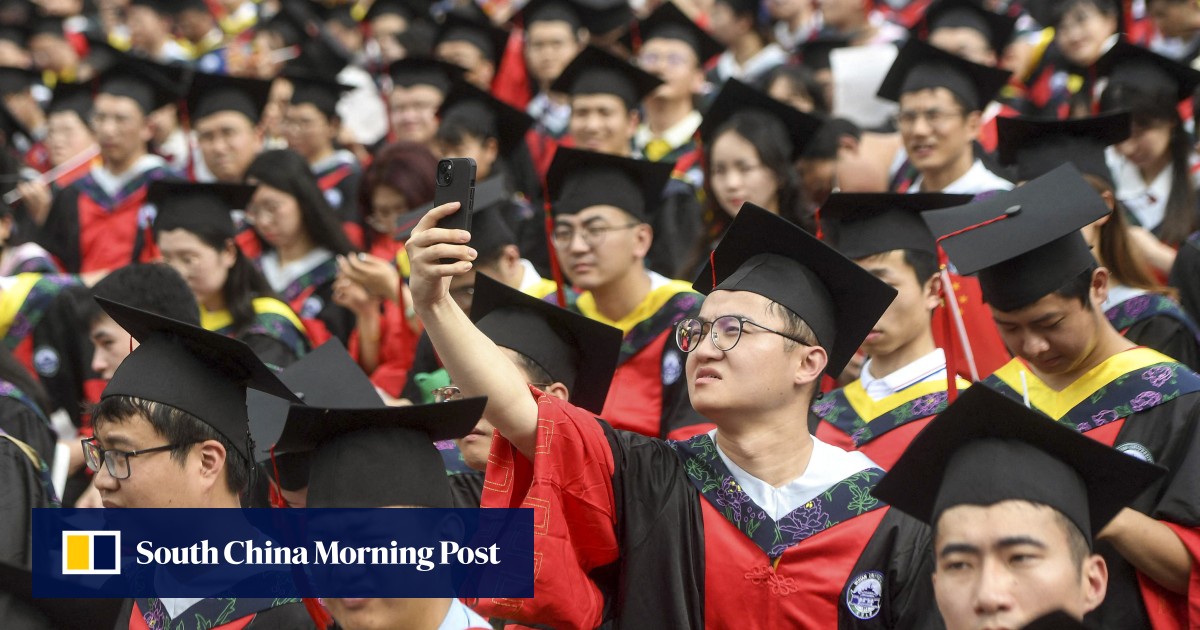Meanwhile, year-end reports on graduate destinations recently issued by higher-education institutions offer a glimpse into how graduates are coping.
The Post has reviewed reports from 24 universities across the country and spotted some of the latest trends.
Chinese universities vow to target fake graduate job data as outlook worsens
Chinese universities vow to target fake graduate job data as outlook worsens
The Post’s review also showed that Chinese universities saw a mild rebound in their graduates’ employment rate from 2022, posting figures in the range of 50 to 70 per cent.
With a large proportion of students seeking further studies, the rates of those who were neither employed nor enrolled ranged from single-digit percentages to as high as a quarter.
For example, Guangdong province’s Wuyi University – ranked No 335 among Chinese universities by the nation’s leading third-party university-ranking group, the Airuishen Alumni Association – reported that about 27 per cent of its 2023 class had not secured a job nor been admitted to a postgraduate programme.
Shanghai Jiao Tong University, one of China’s top-ranked universities, lagged its 2019 levels by 3 percentage points. And Hubei province’s Wuhan Business University – No 453 on the Airuishen list – was 10 percentage points lower.
Many graduates are increasingly pursuing additional education and more degrees as they delay their job hunt, especially students from top universities.
Instead of entering the job market right after graduation, an increasing number of new undergraduate degree holders are choosing to continue their academic studies, with as many as 70 per cent from top universities doing so in 2023.
That has pushed the employment rate for graduates of some of China’s most prestigious universities to some of their lowest levels ever. This includes the universities of Fudan, Shanghai Jiao Tong, Tsinghua and NYU Shanghai.
Only 18 per cent of undergraduate students at Fudan University had landed a job, according to its latest report. And at Tsinghua University, the figure was about 15 per cent.
‘We can’t find the owner’: staff forced to take leave as Chinese firms struggle
‘We can’t find the owner’: staff forced to take leave as Chinese firms struggle
The trend has also pushed universities to combine figures concerning employment and the furthering of education – creating a higher and perhaps less distressing rate.
Several years ago, most of them provided an employment rate that reflected only the number of those who had actually secured a job. But in 2023, nearly all of the universities reviewed by the Post had adopted a new term, “placement rate”, to include those who found work and those who had enrolled in a graduate school.
“The outlook for youth employment this year is not promising in the short term,” said Peng Peng, executive chairman of the Guangdong Society of Reform. He noted how this was reflected in the lowering of gross domestic product (GDP) predictions for 2024, including by the major southern city of Guangzhou, which expects its economy to grow by just 5 per cent his year – lower than the 6 per cent target it set for last year.
“Since the economic prospects are also not optimistic for this year, it will be difficult to fundamentally change the employment outlook,” Peng said.
Overseas opportunities
Despite China reopening a year ago, the number of graduates who opted to study abroad in 2023 did see an increase from 2022, but the figures still lagged behind pre-pandemic levels.
At Tongji University in Shanghai, 590 undergraduate students, or 13.6 per cent, opted to pursue further study outside China in 2023, compared with 547 in 2022. Because of the pandemic, the number had been on the decline since 2019, when 778 students at the university went overseas, or about 20 per cent.
More of those who pursue academic advancements are being absorbed by domestic schools. With the country’s higher-education enrolment ballooning since the turn of the century, matriculations at graduate schools grew nearly tenfold over the same period, to about 1.24 million last year, compared with 128,500 in 2000, according to the Ministry of Education.
Facing increasingly fierce competition in the job market, but backed by richer families, many students are showing a lack of urgency in finding a job, proliferating interest in seeking a higher degree instead.
300 applications, 4 interviews: Chinese foreign graduates face tough job market
300 applications, 4 interviews: Chinese foreign graduates face tough job market
China’s changing face of employment
More graduates in China are ending up in part-time jobs, taking on flexible work or starting their own businesses, rather than jumping directly into a traditional field of work.
And with youth joblessness becoming a more touchy subject after the rate worsened to the point of being withheld by authorities for five months, there are concerns that it could have long-term ramifications on social stability, with economic implications. And universities have responded by padding weak employment figures by including the numbers of freelancers and entrepreneurs among their recent graduates.
In many universities’ reports, an increasing number of graduates who are not bound by formal employment contracts is being reflected in other forms of employment, and thus the graduates are considered employed.
More than 4 per cent of the 2023 class at Jilin University, a leading university in northeastern China – and No 22 on the Airuishen list – have either freelanced or started their own businesses, compared with less than 0.5 per cent in 2019.
And in central China, Hubei University, at No 134 on the Airuishen list, saw 21.5 per cent of its undergraduate students become freelancers or otherwise find employment without signing a labour contract last year. In comparison, that percentage was 17 in 2019.
As China’s gig economy and digital economy grow more lucrative, young flexible workers are finding work in a range of sectors, including food delivery, live streaming, and social media content creation.
But hurdles to employment remain, and some threaten to further curtail job growth.
“Besides the absence of a significant upturn in the economic situation, the impact of China’s rapidly growing e-commerce sector on the traditional real economy, the emergence of AI technology that could increase the likelihood of companies reducing their manpower, and the lack of a notable recovery in the willingness to invest in the private sector – none of these factors are conducive to the growth of job creation,” warned Peng at the Guangdong Society of Reform.


